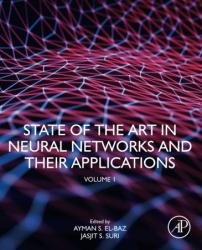 Название: State of the Art in Neural Networks and Their Applications: Volume 1
Название: State of the Art in Neural Networks and Their Applications: Volume 1Автор: Ayman S. El-Baz, Jasjit S. Suri
Издательство: Academic Press/Elsevier
Год: 2021
Страниц: 310
Язык: английский
Формат: pdf (true)
Размер: 15.6 MB
State of the Art in Neural Networks and Their Applications presents the latest advances in artificial neural networks and their applications across a wide range of clinical diagnoses. Advances in the role of Machine Learning, Artificial Intelligence, Deep Learning, cognitive image processing and suitable data analytics useful for clinical diagnosis and research applications are covered, including relevant case studies. The application of Neural Network, Artificial Intelligence, and Machine Learning methods in biomedical image analysis have resulted in the development of computer-aided diagnostic (CAD) systems that aim towards the automatic early detection of several severe diseases.
State of the Art in Neural Networks and Their Applications is presented in two volumes. Volume 1 covers the state-of-the-art Deep Learning approaches for the detection of renal, retinal, breast, skin, and dental abnormalities and more.
Among Deep Learning object detectors, the two-stage Deep Learning (DL) object detectors include R-CNN, fast R-CNN, and faster R-CNN. They share in common that rectangular region proposals are integrated with deep CNNs for object detection. These approaches first search for region proposals from input images that may contain objects and then compute CNN features on these regions. Then, they classify the objects and adjust the boundaries of the region proposals.
1. R-CNN—This approach combines rectangle region proposals and CNNs. The first step is to compute a set of regions that may contain objects, and the second step learns classifiers to classify the regions. The region proposals are generated using edge boxes. The proposals are then cropped and resized to train CNN classifiers. Deep CNNs are used for feature extraction to be plugged into a support vector machine to refine the region proposal bounding boxes.
2. Fast R-CNN—This approach is similar to R-CNN in that it uses algorithms such as edge boxes to generate region proposals. Instead of cropping the proposal regions and resizing them, this approach works on the entire image by pooling CNN features corresponding to each region proposal. This is a more efficient implementation, because it shares computation with overlapping regions.
3. Faster R-CNN—This approach makes further improvement by discarding external algorithms such as the edge boxes. It merges the step of region proposals into the entire network and makes computations more efficient.
The three methods share the same component of R-CNN for object detection. Faster R-CNN makes great improvements over the other two in that it does not rely on external approaches for computing region proposals, which was seen as a bottleneck. After faster R-CNN, several object detectors have been invented for improving efficiency, such as single-shot detector (SSD) and region-based fully convolutional neural networks.
Скачать State of the Art in Neural Networks and Their Applications: Volume 1